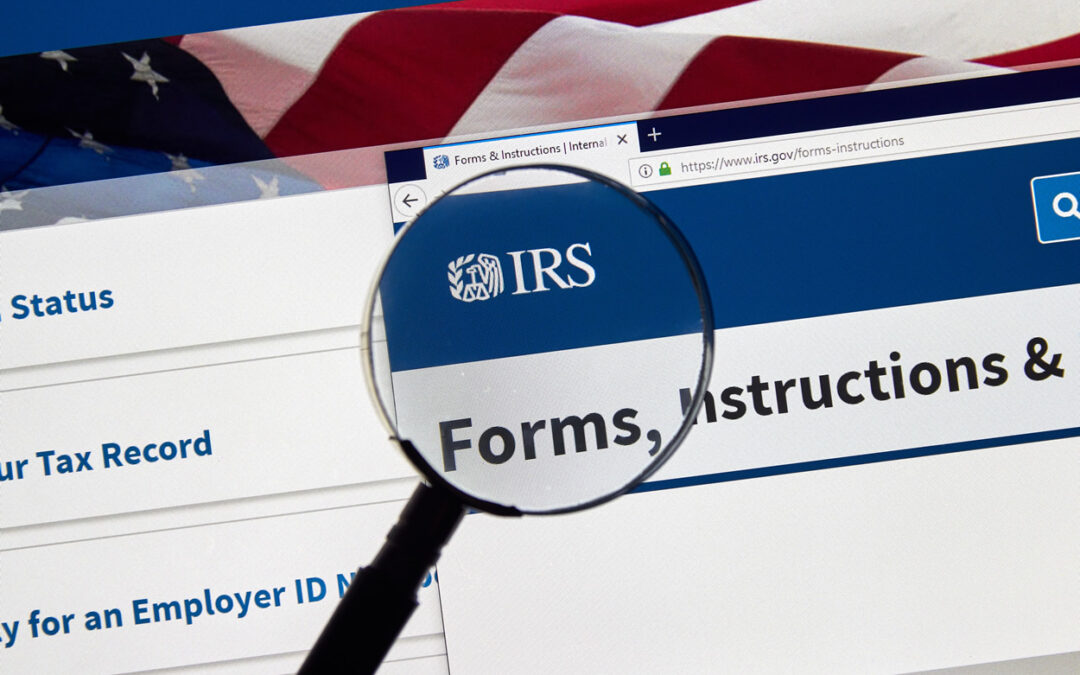
by sreamercpa | Dec 28, 2021 | accounting-tax, IRS
Get ready for taxes: Here’s what’s new and what to consider when filing in 2022
The IRS encourages taxpayers to get informed about topics related to filing their federal tax returns in 2022. These topics include special steps related to charitable contributions, economic impact payments and advance child tax credit payments. Taxpayers can visit IRS.gov/getready for online tools, publications and other helpful resources for the filing season.
Here are some key items for taxpayers to know before they file next year.
Changes to the charitable contribution deduction
Taxpayers who don’t itemize deductions may qualify to take a deduction of up to $600 for married taxpayers filing joint returns and up to $300 for all other filers for cash contributions made in 2021 to qualifying organizations.
Check on advance child tax credit payments
Families who received advance payments will need to compare the advance child tax credit payments that they received in 2021 with the amount of the child tax credit that they can properly claim on their 2021 tax return.
- Taxpayers who received less than the amount for which they’re eligible will claim a credit for the remaining amount of child tax credit on their 2021 tax return.
- Eligible families who did not get monthly advance payments in 2021 can still get a lump-sum payment by claiming the child tax credit when they file a 2021 federal income tax return next year. This includes families who don’t normally need to file a return.
In January 2022, the IRS will send Letter 6419 with the total amount of advance child tax credit payments taxpayers received in 2021. People should keep this and any other IRS letters about advance child tax credit payments with their tax records. Individuals can also create or log in to IRS.gov online account to securely access their child tax credit payment amounts.
Economic impact payments and claiming the recovery rebate credit
Individuals who didn’t qualify for the third economic impact payment or did not receive the full amount may be eligible for the recovery rebate credit based on their 2021 tax information. They’ll need to file a 2021 tax return, even if they don’t usually file, to claim the credit.
Individuals will need the amount of their third economic impact payment and any plus-up payments received to calculate their correct 2021 recovery rebate credit amount when they file their tax return.
In early 2022, the IRS will send Letter 6475 that contains the total amount of the third economic impact payment and any plus-up payments received. People should keep this and any other IRS letters about their stimulus payments with other tax records. Individuals can also create or log in to IRS.gov online account to securely access their economic impact payment amounts.
More information:
Reconciling Your Advance Child Tax Credit Payments on Your 2021 Tax Return

by sreamercpa | Nov 29, 2021 | IRS
Some important things all taxpayers should do before the tax year ends
The IRS reminds taxpayers there are things they should do before the current tax year ends on Dec.31.
Donate to charity
Taxpayers may be able to deduct donations to tax-exempt organizations on their tax return. As people are deciding where to make their donations, the IRS has a tool that may help. Tax Exempt Organization Search on IRS.gov allows users to search for charities. It provides information about an organization’s federal tax status and filings.
The law now permits taxpayers to claim a limited deduction on their 2021 federal income tax returns for cash contributions they made to certain qualifying charitable organizations even if they don’t itemize their deductions. Taxpayers, including married individuals filing separate returns, can claim a deduction of up to $300 for cash contributions to qualifying charities during 2021. The maximum deduction is $600 for married individuals filing joint returns.
Most cash donations made to charity qualify for the deduction. However, there are some exceptions. Cash contributions include those made by check, credit card or debit card as well as unreimbursed out-of-pocket expenses in connection with volunteer services to a qualifying charitable organization.
Check Individual Taxpayer Identification Number
An ITIN only needs to be renewed if it has expired and is needed on a U.S. federal tax return.
If an Individual Taxpayer Identification Number was not included on a U.S. federal tax return at least once for tax years 2018, 2019 and 2020, the ITIN will expire on Dec. 31, 2021.
As a reminder, ITINs with middle digits 70 through 88 have expired. In addition, ITINs with middle digits 90 through 99, if assigned before 2013, have expired. Individuals who previously submitted a renewal application that was approved, do not need to renew again.
Find information about retirement plans
IRS.gov has end-of-year tax information about retirement plans. This includes resources for individuals about retirement planning, contributions and withdrawals.
Contribute salary deferral
Taxpayers can make a salary deferral to a retirement plan. This helps maximize the tax credit available for eligible contributions. Taxpayers should make sure their total salary deferral contributions do not exceed the
$19,500 limit for 2021.
Get banked and set up direct deposit
Direct deposit gives taxpayers access to their refund faster than a paper check. Those without a bank account can learn how to open an account at an FDIC-Insured bank or through the National Credit Union Locator Tool.
Veterans should see the Veterans Benefits Banking Program for access to financial services at participating banks.
Connect with the IRS
Taxpayers can use social media to get the latest tax and filing tips from the IRS. The IRS shares information on things like tax changes, scam alerts, initiatives, tax products and taxpayer services. These social media tools are available in different languages, including English, Spanish and American Sign Language.
Think about tax refunds
Taxpayers should be careful not to expect getting a refund by a certain date. This is especially true for those who plan to use their refund to make major purchases or pay bills. Just as each tax return is unique to the individual, so is each taxpayer’s refund. Taxpayers can take steps now to Get Ready to file their federal tax return in 2022.

by sreamercpa | Nov 6, 2021 | IRS
Year-end giving reminder: Special tax deduction helps most people give up to $600 to charity, even if they don’t itemize
WASHINGTON – The Internal Revenue Service today reminded taxpayers that a special tax provision will allow more Americans to easily deduct up to $600 in donations to qualifying charities on their 2021 federal income tax return.
Ordinarily, people who choose to take the standard deduction cannot claim a deduction for their charitable contributions. But a temporary law change now permits them to claim a limited deduction on their 2021 federal income tax returns for cash contributions made to qualifying charitable organizations. Nearly nine in 10 taxpayers now take the standard deduction and could potentially qualify.
Under this provision, individual tax filers, including married individuals filing separate returns, can claim a deduction of up to $300 for cash contributions made to qualifying charities during 2021. The maximum deduction is increased to $600 for married individuals filing joint returns.
Included in the Coronavirus Aid, Relief, and Economic Security (CARES) Act, enacted in March 2020, a more limited version of this temporary tax benefit originally only applied to tax-year 2020. The Taxpayer Certainty and Disaster Tax Relief Act of 2020, enacted last December, generally extended it through the end of 2021.
Cash contributions include those made by check, credit card or debit card as well as amounts incurred by an individual for unreimbursed out-of-pocket expenses in connection with their volunteer services to a qualifying charitable organization. Cash contributions don’t include the value of volunteer services, securities, household items or other property.
The IRS reminds taxpayers to make sure they’re donating to a recognized charity. To receive a deduction, taxpayers must donate to a qualified charity. To check the status of a charity, they can use the IRS Tax Exempt Organization Search tool.
Cash contributions to most charitable organizations qualify. But contributions made either to supporting organizations or to establish or maintain a donor advised fund do not. Contributions carried forward from prior years do not qualify, nor do contributions to most private foundations and most cash contributions to charitable remainder trusts.
In general, a donor-advised fund is a fund or account maintained by a charity in which a donor can, because of being a donor, advise the fund on how to distribute or invest amounts contributed by the donor and held in the fund. A supporting organization is a charity that carries out its exempt purposes by supporting other exempt organizations, usually other public charities.
Keep good records Special recordkeeping rules apply to any taxpayer claiming a charitable contribution deduction. Usually, this includes obtaining an acknowledgment letter from the charity before filing a return and retaining a cancelled check or credit card receipt for contributions of cash. For details on the recordkeeping rules for substa

by sreamercpa | Aug 30, 2021 | IRS
September is National Preparedness Month. With the height of hurricane season fast approaching and the ongoing threat of wildfires in some parts of the country, the Internal Revenue Service reminds everyone to develop an emergency preparedness plan.
All taxpayers, from individuals to organizations and businesses, should take time now to create or update their emergency plans.
Taxpayers can begin getting ready for a disaster with a preparedness plan that includes securing and duplicating essential tax and financial documents, creating lists of property and knowing where to find information once a disaster has occurred. Securing this information can help in the aftermath of a disaster, and it can help people more quickly take advantage of disaster relief available from the IRS.
Start secure
Taxpayers should keep critical original documents inside waterproof containers in a secure space. Documents such as tax returns, birth certificates, deeds, titles and insurance policies should also be duplicated and kept with a trusted person outside the area a natural disaster may affect.
Make copies
If original documents are available only on paper, taxpayers can use a scanner and save them on a USB flash drive, CD or in the cloud, which provide security and easy portability.
Document valuables
After a disaster hits, photographs and videos of a home or business’s contents can help support claims for insurance or tax benefits. All property, especially expensive and high- value items, should be recorded. The IRS disaster-loss workbooks can help individuals (.pdf) and businesses (.pdf) compile lists of belongings or business equipment.
Employer fiduciary bonds
Employers using payroll service providers should check if their provider has a fiduciary bond in place to protect the employer in the event of a default by provider. Employers are encouraged to create an Electronic Federal Tax Payment System account at EFTPS.gov to monitor their payroll tax deposits and receive email alerts.
Know where to go
Reconstructing records after a disaster may be required for tax purposes, getting federal assistance or insurance reimbursement. Find out if financial institutions provide statements and documents electronically. Taxpayers who have lost some or all of their records during a disaster should visit IRS’ Reconstructing Records webpage.
IRS is ready to help
Taxpayers living in a federally declared disaster can visit the IRS Tax Relief in Disaster Situations webpage or Around the Nation on IRS.gov and check for the available disaster tax relief. The IRS automatically identifies taxpayers located in the covered disaster area and applies filing and payment relief. Affected taxpayers can call 866-562-5227 to speak with an IRS specialist trained to handle disaster-related issues.
A taxpayer impacted by a disaster outside of a federally declared disaster area may qualify for disaster relief. This includes taxpayers who are not physically located in a disaster area, but whose records necessary to meet a filing or payment deadline postponed during the relief period are located in a covered disaster area.
For more information about National Preparedness Month, visit Ready.gov/September.

by sreamercpa | Jul 12, 2021 | child-tax-payments, IRS
The first monthly payments of the expanded and newly-advanceable Child Tax Credit from the American Rescue Plan will be made starting July 15. Most families will begin receiving monthly payments without any additional action. Eligible families will receive a payment of up to $300 per month for each child under age 6, and up to $250 per month for each child ages 6 to 17.
People who don’t need to file a 2020 federal tax return can also use the Non-filer Sign-up Tool to register to receive the advance CTC payments, the Third Round Economic Impact Payment, and the Recovery Rebate Credit.
The IRS encourages people to request payments via direct deposit, which is faster and more secure than other payment methods. People who don’t have a bank account should visit the Federal Deposit Insurance Corporation website for details on opening an account online. They can also use the FDIC’s BankFind tool to locate an FDIC-insured bank.
People can check their eligibility for the AdvCTC payments by using the new Advance Child Tax Credit Eligibility Assistant.
This link will also taxpayers to opt out of receiving the advanced tax credit if they prefer to receive the entire credit at one time when they file their 2021 federal income tax return. However, you must create a separate account for both the taxpayer and spouse since the IRS requires both parents in a two-parent household to unenroll separately.
It is too late to opt out of the July 15 payment, but you can opt out of all subsequent payments if you sign up now.
Finally, like the 2020 stimulus payments, this is an advance against the actual credit that will be calculated when taxpayers prepare their 2021 tax returns. So taxpayers must keep track of all advance payments received to prevent delays in the IRS processing their 2021 tax refunds.

by sreamercpa | Jun 23, 2021 | IRS
The IRS has opened an online site to enable taxpayers to unenroll from receiving advance payments of the 2021 child tax credit (CTC).
The new “Child Tax Credit Update Portal” allows parents to view their eligibility, view their expected CTC advance payments, and, if they wish to do so, unenroll from receiving advance payments (i.e., to opt out). Unenrolling may be desirable if, for instance, taxpayers expect the amount of tax they owe to be greater than their CTC refund when they file their 2021 tax return.
In a set of new FAQs, the Service answers questions about unenrolling from the CTC advance payments.
2021 child tax credit
Under the American Rescue Plan Act (ARPA), P.L. 117-2, the IRS must make 2021 periodic advance child tax credit payments to taxpayers up to the “annual advance amount.” These payments — up to $300 per month per child under age 6 and up to $250 per month per child age 6 through 17 — will be paid in equal amounts and made no earlier than July 1, 2021, and no later than Dec. 31, 2021.
For tax year 2021 only, ARPA increased the child tax credit amount to up to $3,000 for each qualifying child between age 6 and 17 at the end of the 2021 tax year, and $3,600 for each qualifying child under age 6 at the end of the 2021 tax year. ARPA also made the child tax credit for 2021 fully refundable if the taxpayer (or spouse, on a joint return) has a principal place of abode in the United States for more than one-half of the 2021 tax year.
Last week, the Service opened an online site called the “Non-Filer Sign-Up Tool” that enables parents who are not required to file a 2019 or 2020 individual income tax return to sign up to receive 2021 CTC advance payments.
The IRS also, in Rev. Proc. 2021-24, clarified how individuals who are not otherwise required to file 2020 returns can claim 2021 CTC advance payments by either filing simplified returns or electronically filing a 2020 return with zero adjusted gross income.






